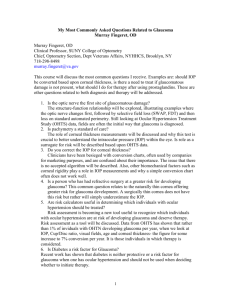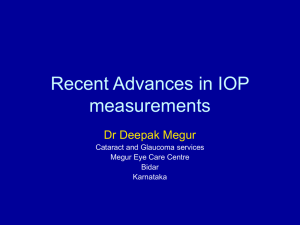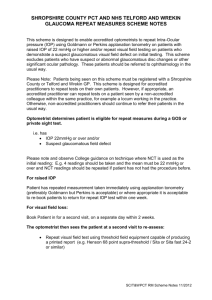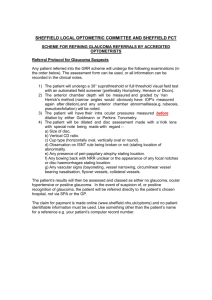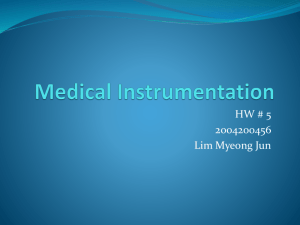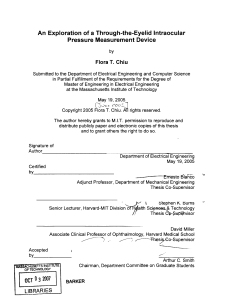NYU PGY-2 Ophthalmology Basics Guide
advertisement
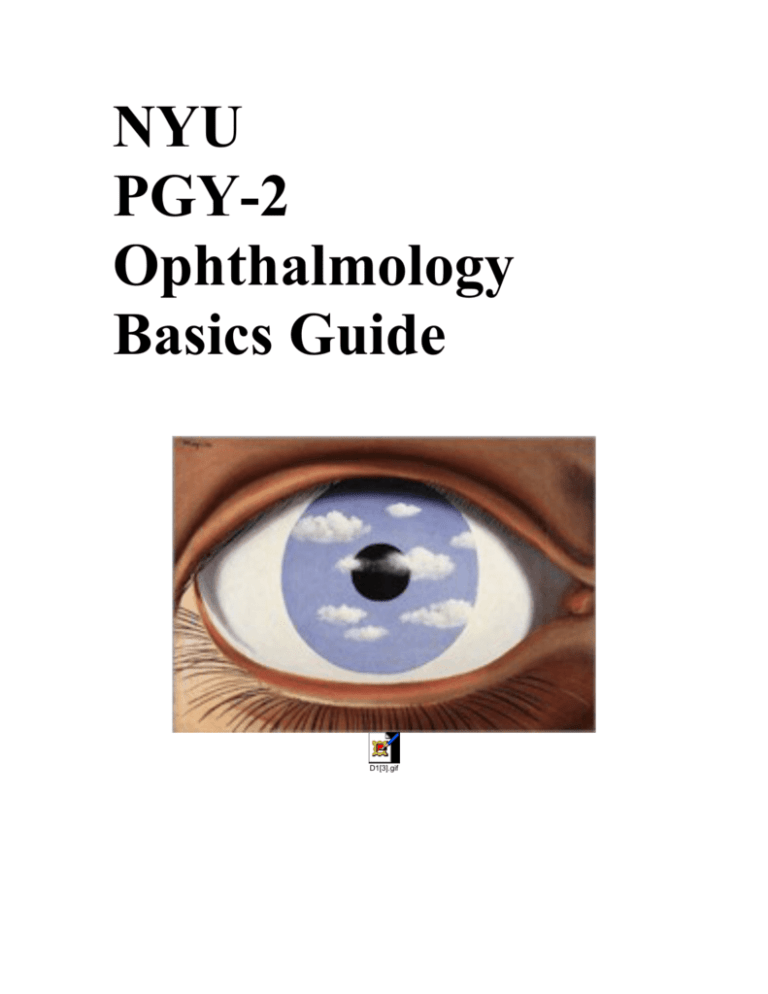
NYU PGY-2 Ophthalmology Basics Guide D1[3].gif PREFACE NYU offers its medical students an elective course in Ophthalmology. Oftentimes, students start the elective and find that they are unfamiliar with the “ophthalmic lingo,” ophthalmic history, and especially the ophthalmic consultation note. This compilation addresses the format of the eye examination, focusing on familiarizing the student with the eye examination, as well as translating information recorded in the eye note. A brief glossary of drugs and ophthalmic terms, as well as an explanation of notations, abbreviations, and acronyms is included. In addition, guides in helping the student with specific ophthalmic techniques, such as Goldmann applanation and Schiotz tonometry, application of ophthalmic drugs, direct and indirect ophthalmoscopy, and examination of the pupils, is included. Lastly, general guidelines for ophthalmic followup as practiced by our residents is covered. No guidelines for treatment or patient management is addressed. These must be learned through experience in the eye clinic, passing on skills from faculty to residents to students, and supplemental reading. ACKNOWLEDGEMENTS Information included in this compilation was obtained from the following texts: 1) Will’s Eye Manual. Cullom, Lippincott Raven Publishers, 2nd Edition. 1994. 2) Ophthalmology Made Ridiculously Simple. Goldberg MedMaster, 1st Edition. 1991. 3) A Manual for the Beginning Ophthalmology Resident. American Academy of Ophthalmology, Custom Printing, Inc. USA, 3rd Edition. 1980. 4) Phillips C., Clark C., Tsokahara S. Ophthalmology: A Primer for Medical Students and Practitioners. Bailliers Tindall, London. 1994. 2 TABLE OF CONTENTS I. II. III. IV. V. VI. VII. VIII. IX. X. XI. XII. XIII. Preface………………………………………………………. Pg. 2 Acknowledgements………………………………………….. Pg. 2 Table of Contents……………………………………………..Pg. 3 Practical Checklist………………………………………….... Pg. 4 Rosetta Stone to the Hieroglyphic Ophthalmic Note……...………………………..Pg. 6 Representative Eye Note of Completely Normal Exam……………………………….…....Pg. 7 Notations, Abbreviations, and Frequently Used Acronyms…………………………………...Pg. 8 Specific Ophthalmic Techniques…………………………….Pg. 10 A. Assessment of Visual Acuity…...…………………….Pg. 10 B. The Direct Ophthalmoscope…………..…………..... .Pg. 10 C. The Indirect Ophthalmoscope………………………..Pg. 12 D. The Application of Fluorescein Strips and Ophthalmic Drops………………..……….Pg. 12 E. Tonometry……………………………………………Pg. 13 F. Examination of the Pupils………………………….…Pg. 15 Glossary…………………………………………………….. Pg. 17 A. Ophthalmic Terms……………………………………Pg. 17 B. Ophthalmic Drugs………………………………….…Pg. 19 General Guidelines for Ophthalmic Follow-Up………………………………………Pg. 22 The Red Eye Chart…………………………………………...Pg. 24 Sample Picture of Rosenbaum Pocket Vision Screener…...………………………………….Pg. 25 Diagram of Anatomy of the Globe…………………………..Pg. 26 3 PRACTICAL CHECKLIST Section A You should do the following: 1) Take three full histories and write them down 2) Go through the full eye examination on at least three patients and present your findings to a resident 3) Take and record distance visual acuity 4) Take and record reading (near) visual acuity 5) Use a pinhole 6) Examine ocular movements 7) Test convergence 8) Test the pupillary reactions Section B You should see the following: a. Clinical cases i. Cataracts ii. Pseudophakia iii. Diabetic retinopathy (several) iv. Macular degeneration v. Glaucomatous disc cupping (several) vi. Chalazion, pinguecula, pterygium (several) 4 b. Tests to be familiar with i. Visual fields ii. Applanation tonometry (do yourself) iii. Gonioscopy iv. Amsler chart v. Color vision tests vi. Slit lamp biomicroscopy (do yourself) vii. Indirect ophthalmoscopy (try yourself) viii. Schirmer’s tear test ix. Corneal staining with fluorescein strips (do yourself) x. Intravenous injection of fluorescein with fundus photography, and several fundus photographs (In fluorescein angiography, an arm vein is injected with a fluorescein material that is photographed as it passes through the retinal vessels. The technique is extremely useful in diagnosing and treating many conditions. Fluorescein angiography is most frequently performed in retinal vascular diseases: diabetic retinopathy, retinal vein occlusion, and macular degeneration with choroidal neovascularization. In diabetic retinopathy, angiography may detect microaneurysms and areas of vessel leakage to help determine which areas to treat with laser photocoagulation.) 5 ROSETTA STONE TO THE HIEROGLYPHIC OPHTHALMIC NOTE Date: CC: HPI: POHx: Past Ocular History PMHx: Meds: ALL: VA 20/ 20/ TAP mmHg mmHg FHx: Top entry is right eye, unless otherwise specified EOM DFE C/D M BV R V SLE cup/disc (The optic disc is graded by comparing the diameter of the cup to the diameter of the disc. This is expressed as a decimal, e.g., 0.3. The cup/disc ratio is less than or equal to 0.3 in most individuals.) macula blood vessels retina vitreous L/A C/S C AC I/P L/M IMPRESSION/PLAN: RTC Signature PGY-year 6 lids/adnexa conjunctiva/sclera cornea anterior chamber iris/pupil lens/media SAMPLE NOTE OF COMPLETELY NORMAL EYE EXAM Date: 4/3/2003 CC: Routine eye exam, first visit, no complaints HPI: 38 year old WM w/ no significant PMHx POHx: None PMHx: No HTN, no DM, no COPD Meds: None ALL: NKDA VA 20/20 20/20 TAP 10:15am 15 mmHg 15 mmHg FHx: No glaucoma No diabetes EOM Full OU DFE m1%, N2.5% 10:25am SLE L/A WNL OU C/S W&Q OU C Clear OU AC D&Q OU I/P ERRL no APD OU L/M Clear OU C/D 0.32 OU, s/p/f M + FR OU BV WNL OU R No heme, no exudates V Clear OU IMPRESSION/PLAN: Normal eye exam RTC: 3-5 years or sooner prn PGY-3 7 NOTATIONS, ABBREVIATIONS, AND FREQUENTLY USED ACRONYMS VA Visual acuity: the cc or sc means with or without correction. PH means that a pinhole was used. If vision improves with PH, it may indicate a refractive error. If vision does not improve with PH or refraction, you must rule out any pathology for decreased VA TAP Tonometry, or intraocular pressure (IOP) measurement. The letters AP stand for the method used, applanation. TS means Schiotz method of tonometry. OD OS OU Ocular dexter – right eye Ocular sinister – left eye Ocular uterque – both eyes SLE Slitlamp Exam: DFE Dilated Fundus Exam: ACIOL AION ALT APD ARMD BRAO BRVO CL CME CRAO CRVO COAG WNL W&Q D&Q C/F APD within normal limits white & quiet (normal) deep & quiet (normal) cell & flare afferent pupillary defect (Marcus Gunn Pupil) S/F/P sharp, pink, flat (normal) FR foveal reflex (normal in children, young adults MA microaneurysms HE hard exudates D/B dot/blot hemorrhages CWS cotton wool spot M1%, N2.5% typical dilating drops Mydriacil (tropicamide) and Neosynephrine (phenylephrine) anterior chamber intraocular lens anterior ischemic optic neuropathy argon laser trabeculoplasty afferent pupillary defect age-related macular degeneration branch retinal artery occlusion branch retinal vein occlusion contact lens cystoid macular edema central retinal artery occlusion central retinal vein occlusion chronic open angle glaucoma 8 CSME ECCE GONIO ICCE IOP KP LI MCE NAG PBK PHACO PCIOL PK PRK PRP PVD RD RK RPE SPK TRAB VF VH clinically significant macular edema extracapsular cataract extraction gonioscopy intracapsular cataract extraction intraocular pressure keratic precipitates laser iridotomy microcystic edema narrow angle glaucoma pseudophakic bullous keratopathy phacoemulsification posterior chamber intraocular lens penetrating keratectomy photorefractive keratectomy panretinal photocoagulation posterior vitreal detachment retinal detachment radial keratotomy retinal pigment epithelium superficial punctate keratitis trabeculectomy (glaucoma surgery) visual field vitreous hemorrhage MEDICINES A B C D E H P Pr T Tr gtts ung Atropine Betoptic Cyclogyl Diamox Epinephrine Homatropine Pilocarpine Propine Timoptic Trusopt abbrev. for drops abbrev. for ointment 9 SPECIFIC OPHTHALMIC TECHNIQUES A. Assessment of Visual Acuity The most commonly used tests for visual acuity are the distance (Snellen) vision chart and near (Rosenbaum) vision chart. Each eye should be tested separately. When covering one eye, make sure that the patient is not pressing on the eye, as this may temporarily interfere with visual acuity when the covered eye is tested. 20/20 means that the patient can read, at 20 feet, the same number of lines that the average person can read at 20 feet. 20/200 would mean that the patient, at 20 feet, can read no more lines than the average person can read at 200 feet. Visual acuity may be recorded up to 20/400 or 20/800, but beyond that is recorded as FC (Finger Counting), HM (Hand Motion), LP (Light Perception), and NLP (No Light Perception). The patient should be tested with his/her glasses. Make sure you are using the distance glasses when testing distance vision and reading glasses when testing near vision. If wearing bifocals, make sure that the patient is looking through the top part of the glasses when measuring distance vision and the bottom part of the glasses when measuring near vision. Examples of visual acuity recordings: VA SC 20/400 20/50 -2 PH PH 20/30 20/30 This indicates that distance vision without correction is 20/400 OD and 20/50 –2 OS (the patient read the 20/50 line except for two letters). Both eyes pinhole to 20/30. VA CC 20/60 20/70 PH PH 20/25 20/20 This indicates that the distance vision with correction is 20/60 OD and 20/70 OS. The right eye only corrects to 20/25 with pinhole and the left eye corrects to 20/20 with pinhole. Legal blindness is usually accepted by state legislators as visual acuity of 20/200 with best correction in the better seeing eye, and/or visual field restricted to a 20 degree diameter or less in the better eye. B. The Direct Ophthalmoscope The direct ophthalmoscope becomes much less challenging to use in this non-dilated patient once the student has had experience has had experience viewing many dilated pupils. If nothing else, it is hoped that anyone rotating through the clinic will feel comfortable using 10 the direct ophthalmoscope since both the ophthalmologist and non-ophthalmologist employ this instrument frequently. The instrument provides 15x magnification, and the image is real. A diagram of the direct ophthalmoscope: 1) Mirror that reflects light into the patient’s eye with a viewing hole above, through which the examiner looks. 2) Handle where battery power is supplied. On top of the handle is a rheostat for light adjustment. 3) Headrest bar, which goes against the examiner’s forehead. 4) Viewing hole through which the examiner looks. It is this hole that lenses may superimpose for focus. 5) Focusing wheel, with which the examiner can, using their index finger, adjust the lenses in the viewing hole while holding the ophthalmoscope. 6) As the dial wheel is moved, the power of the lens is indicated in this small window. Red numbers indicate minus lenses, and black numbers indicate plus lenses. How to Examine the Patient: 1) Use your right eye to visualize the patient’s right eye and your left eye to visualize the patient’s left eye. 2) Have the patient look straight ahead at a distant object. 3) Obtain a red reflex in the patient’s eye while looking through the ophthalmoscope. This is best achieved from a position about 15 inches away from the patient and about 20 degrees lateral to the patient’s line of vision. 11 4) Move close to the patient keeping the red reflex on the 20 degree line toward the pupil. Proceed until you are close enough to rest your hand on the patient's cheek. Use the large round white light in the undilated patient (which will help reduce glare). 5) Start with focusing the wheel on 0, them move the wheel back and forth until a setting is found with a segment of retinal vessel in focus. Use your index finger to turn the wheel. 6) Follow the retinal vessel back to the patient’s optic nerve. Remember, your field of view will be narrow (not much more than two disc diameters at a time). 7) The optic nerve lies slightly nasal to the center of the retina. Note the disc’s outline, shape, color, and size. Assess the papilledema, optic atrophy, and glaucoma. 8) Examine the blood vessels that enter the cup for venous pulsations. 9) Follow each arcade of blood vessels out as far as you can and observe them for arteriolar narrowing and the adjacent retina for hemorrhages and exudates. 10) Examine the macula and fovea, noting the normal foveal reflex centrally and the slight hyperpigmentation. Note any intense pigmentation, scars, or hemorrhages that may explain reduced visual acuity. C. The Indirect Ophthalmoscope The indirect ophthalmoscope is generally used only by ophthalmologists; it is expensive and a much more difficult technique to master that direct ophthalmoscopy. With this instrument, the examiner wears a bright headlight for direct illumination and examines the retina through a hand held lens. It provides stereopsis, enables a clearer visualization through hazy media, reveals a larger field of view, and permits good examination of the peripheral retina. The image seen is vertically inverted and laterally reversed. The scope should be positioned and comfortably on the head and supported by the band going over the head and not by tightening the band going around the head. The light should be aimed for direct illumination of the fundus when focused through the lens. When aligning the light, lens, and pupil, you should concentrate on the pupil as the lens is moved to permit focusing on the retina. The most commonly used lenses for indirect ophthalmoscopy are the 20 and 30D lenses. They all have white outlined rings on one side, which should be held oriented toward the patient. Remember your head should be arm’s length from your lens to obtain the best view. D. The Application of Fluorescein Strips and Ophthalmic Drops Fluorescein is supplied as paper strips. Only a small amount need be applied in the eye for good viewing. If the eye is tearing, it is not necessary to wet the strip. If the eye is dry, wet only a corner of the strip with proparacaine (Ophthetic, Ophthaine, Alkaine). Never touch the cornea with the strip, as it will cause pain and create an artifactual corneal defect. Touch the lower fornix with the strip while the patient looks up. Fluorescein is a water soluble acidic dye that produces an intense green fluorescent color in alkaline solution when 12 illuminated with a blue or fluorescent light. A break in the corneal epithelium permits fluorescein penetration, and a bright green appearance of the affected corneal region results. Ophthalmic drops and ointments should also be applied to the lower fornix in order to avoid irritating the cornea. The eye only accommodates a few drops, so there is little concern about applying too much, as the excess will not stay in the eye. E. Tonometry Assessment of intraocular pressure (IOP) can be done using one of many modalities. In our clinics, the slitlamps are equipped with Goldman applanation tonometers. Determination of IOP is important in the evaluation of glaucoma, traumatic injuries, inflammation, and retinal detachment, just to name a few conditions. This ophthalmic technique is called tonometry. A diagram of the Goldmann’s applanation tonometer: To use the instrument-mounted Goldmann’s tonometer: 1) Clean the tip of the tonometer with an alcohol swab. If an HIV+ patient’s IOP is measured, make sure the tip is sterilized and replaced with a new sterilized tip. 2) Check to see that the applanation prism is horizontally aligned at 180 degrees. 3) Instill a drop of proparacaine into the eye, then apply some fluorescein. 4) Position the patient at the slitlamp with the forehead firmly against the headrest, looking straight ahead of fixating on your ear. 5) Using the cobalt blue filter with the brightest beam projected at the applanation prism, center the prism directly in front of the corneal apex. 6) Preset the spring tension dial between 1 and 2 (between 10 and 20 mmHg). 7) Have the patient blink and gently advance the slitlamp, looking around until the tonometer just touches or is about to touch the cornea. 8) Quickly switch to viewing the eye through the ocular on the left hand side. Two semicircles should be visible. The inner margins of the semi-circles should just kiss for correct IOP measurement. 9) All adjustments of the dial should be made with the instrument momentarily backed away from the cornea to prevent inadvertent corneal trauma. 13 10) Pulse pressures will create some fluctuations in the mire pattern. Diastole will separate the inner margins and systole will overlap them. Normal IOP’s are considered to range from about 8 to 22 mmHg. Decrease dial setting Increase dial setting Applanation tonometer mire ring patterns: Correct reading of IOP The Schiotz tonometer is a portable hand-held instrument which makes is available for use in the emergency and operating rooms. The device has a footplate that fits directly over the cornea. In the center of the footplate is a hole through which a plunger moves. As the plunger indents the cornea, a pointer records readings on a scale. The plunger and its weight (adjusted by adding heavier or lighter metal disks) indent the cornea. The amount of indentation of the cornea depends upon the IOP. The higher the IOP, the less indentation; the lower the IOP, the more the indentation. Therefore higher scale numbers correspond to lower pressures, and lower scale numbers to higher pressures. One must always calibrate the instrument by positioning the footplate with the weighted plunger in place on a solid convex surface provided in the instrument case. The plunger, in this instance, should register at 0 (since there is no indentation), which corresponds to a very high pressure. With each tonometer, a chart for converting scale readings to IOPs in mmHg is provided. When using the tonometer, you should routinely start with a baseline weight of 5.5 g. If a reading less than 3.0 is obtained, heavier weights should be used until the scale reading is at least 3.0. A diagram of the Schiotz tonometer: 14 1) Patient’s eye 2) Weight (5.5g) 3) Pointer 4) Scale 5) Footplate 6) Plunger The technique of Schiotz tonometry is quite simple: 1) Instill a drop of anesthetic into the patient’s eye. 2) Place the patient in a supine position so that the eye is looking straight up. 3) Gently spread the eyelids, being careful not to apply any pressure on the globe. 4) Place the tonometer in a vertical position directly on the cornea with the plunger inside the footplate exerting its full weight. 5) Read the scale and use the calibration chart to convert the pressure to mmHg. Remember the lower scale reading, the higher the IOP. Calibration Chart for Schiotz Tonometry (Intraocular Pressure): Tonometer Reading Scale 2.5 3.0 3.5 4.0 4.5 5.0 5.5 6.0 6.5 7.0 7.5 8.0 8.5 9.0 9.5 10.0 5.5 27 24 22 21 19 17 16 15 13 12 11 10 9 8 8 7 Tonometer Eights (grams) 7.5 39 36 33 30 28 26 24 22 20 18 17 16 14 13 12 11 10.0 55 51 47 43 40 37 34 32 29 27 25 23 21 20 18 16 F. Examination of the Pupils Carefully observe the size of the pupils in both bright and dim light. Dim light will enhance a subtle inequality that might otherwise be missed. Any abnormalities in the normal round shape of the pupil should be recorded and investigated at the slit lamp. A bright light source is needed to adequately assess the direct pupillary response to light. It should be recorded as brisk or sluggish. The light source should be angled into the pupil so that the patient is not looking straight into the light. The swinging flashlight test compares the direct and consensual responses in the same eye. It is used to document an APD, which is commonly found in optic nerve disease. Shine your bright light into one eye, watching the response. Then swing the light to shine into the other eye. The first reflex of that pupil is observed for miosis. If normal conduction is present in both eyes, crisp miosis occurs bilaterally as the light is swung back and forth. If, on the other hand, conduction is impaired in one eye, swinging the light from the intact eye to the impaired eye will produce paradoxical dilatation in the impaired eye. The direct response is less intense that the consensual response created a second earlier in that same eye. This finding is known as an afferent pupillary defect (APD) or a Marcus Gunn pupil. Ambient Light (5mm) Direct Light Reflex, OD (2mm) Consensual Reflex, OS Swinging Flash… …light Test Ambient Light (5mm) DEFECT Constriction Directly (4mm) Constriction Consensually (2mm) Paradoxical Dilatation (4mm) 16 NORMAL GLOSSARY A. Some Basic Ophthalmic Terms Amblyopia partial loss of sight acquired during childhood (from strabismus, marked refractive asymmetry, or deprivation) Ametropia condition in which there is a refractive error Anisometropia ignificant difference in the refractive power of the eyes Aphakia absence of the lens of the eye (e.g., after cataract surgery) Arcus senilus opaque, grayish ring at the periphery of the cornea within the sclerocorneal junction, commonly seen in the aged, and most often resulting from a deposit of fatty granules Amsler Grid a test useful in detecting subtle, early changes of metamorphopsia (visual distortion) in macular disease Chalazion chronic granuloma in the tarsus due to inflammation of a Meibomian gland Cyclopegia paralysis of accommodation due to loss of power of the ciliary muscle Dermatochalasis herniation of orbital fat into the upper and/or lower eyelids, usually due to age Diopter the unit of refracting power of lenses, denoting the reciprocal of the focal length in meters Diplopia double vision Emmetropia state of having no refractive error Enophthalmos recession of the globe into the orbit Esophoria tendency of the eyes to deviate inward (latent) Esotropia crossed eyes inward (manifest) Exophthalmos forward displacement of the globe Exophoria tendency of the eyes to deviate outwards (latent) Exotropia crossed eyes outward (wall-eyed) (manifest) Fovea central 1.5mm of the macula, where mainly cones are present Gonioscopy examination of the angle of the anterior chamber of the eye with a gonioscope (special mirrored lens) and beam illumination; also used to study the entire retina with stereopsis and magnification Hordeolum stye; acute infection of a marginal gland of the eyelid Hyphema blood in the anterior chamber Hypopyon pus in the anterior chamber Limbus sclerocorneal junction Macula central 5mm of the retina responsible for acute central vision Miosis constriction of the pupil Photophobia dilation of the pupil Photorefractive Keratectomy a surgical method to correct refractive errors which reduces the radial curvature of the cornea with an Excimer laser. This procedure is considered safer than RK because less penetration of the corneal stroma is required Pinguecula yellowish spot adjacent to cornea due to connective tissue thickening of conjunctiva Proptosis forward displacement of the globe Pseudophakia presence of an artificial intraocular lens (IOL) Pterygium triangular patch of hypertrophied bulbar subconjunctival tissue extending from the medial canthus to the border of the cornea or beyond, with apex pointing toward the pupil Ptosis drooping of the lid, usually the upper lid Radial Keratectomy a surgical method to correct refractive errors which flattens the cornea by creating radial incisions around an axial circle, thus reducing the focusing power Refraction the alteration in the direction of a wave form when passing from one medium to another of a different density. One of the most important functions of the eye is to refract rays of light and bring them to focus on the retina. A refractive error describes the situation where the light rays are not focused on the retina. In performing a refraction, glasses can be prescribed which help to focus images appropriately on the retina. 18 Strabismus ocular misalignment, whether due to abnormalities in binocular vision or anomalies of neuromuscular control of ocular motility Symblepharon adhesion of the palpebral conjunctiva of the eyelid to the bulbar conjunctiva of the globe, often seen in Stevens-Johnson syndrome Synechia adhesion of the iris to anything within the anterior chamber, usually adhesion of the iris to the anterior lens capsule as a result of the inflammatory process in anterior uveitis Uveitis inflammation of any part of the uveal tract B. Some Basic Ophthalmic Drugs Eye medications should be listed with the current dosage regimen. You should ideally record the time of the most recent administration of the medicines for treatment of glaucoma. Most clinic patients cannot remember the names of their medications. Containers for eye drops have colored tops. Green tops generally indicate cholinergic drugs (pilocarpine, etc.); red is used for anticholinergic drugs (atropine, homatropine, cyclopentelate, tropicamide, etc.). Timolol and betaxalol are beta blockers packed in bottles with yellow and blue tops, respectively. Trusopt, a orange topped topical carbonic anhydrase inhibitor, is used for glaucoma. White tops are used for a wide variety of antibiotics, artificial tears, and steroids. Acetazolamide (Diamox) Carbonic anhydrase inhibitor; sulfonamide wuth diuretic action in the renal tubules. Causes reduction in IOP by decreasing aqueous humor secretion. Indicated primarily in treatment of COAG Alomide An ophthalmic solution containing the mast cell stabailizer lodoxamide tromethamine used for the treatment of vernal (allergic) conjunctivitis Atropine Cycloplegic mydriatic; anticholinergic response blocks cholinergic stimulation of the iris sphincter muscle and ciliary body, producing pupillary dilation and cycloplegia. Used mostly for cycloplegic refraction in children, and to cause mydriasis and prevent synechiae formation associated with uveitis Betaxolol (Betoptic) Beta-adrenergic blocker; cardioselective beta 1 adrenergic blocking agent (spares beta 2 pulmonary receptor). Reduces IOP by a decrease in aqueous humor protection. Used mostly in treatment of COAG Cyclopentolate See Atropine Dipivefrin (Propine) Sympathomimetic; reductionof IOP occurs through he decrease in aqueous humor formation and the enhancement in outflow facility. Used mostly in COAG Epinephrine Sympathomimetic; action similar to dipivefrin Fluoromethalone Corticosteroid; anti-inflammatory action exerted through suppression 19 of edema, vascularization, and fibroplatic proliferation. Used in treatment of inflammatory conditions of the palpebral and bulbar conjunctiva, lid, cornea, and uvea. This drug is used in preference to prednisolone acetate in steroid responders (patients who have elevated IOP with chronic steroids) since it has a lower propensity to increase IOP Healon High molecular weight, high viscosity, transparent and non-antigenic Solution of sodium hyaluronate. Used as a surgical aid in anterior and posterior segment procedures, especially cataract surgery. It also protects the corneal endothelial cells and other ocular structures for up to 6 days Homatropine Cycloplegic mydriatic; see atropine. This solution used primarily in treatment of iritis Iopidine (Aproclonidine) Alpha-adrenergic agonist that lowers IOP through the reduction in aqueous production. Used mostly to control post-surgical rises in IOP occurring after laser trabeculoplasty or laser iridotomy Latanaprost Synthetic prostaglandin; functions as an IOP lowering agent by promoting uveoscleral outflow of aqueous humor Mannitol Hyperosmolar; systemic hypersmotic agent that results in an increase in serum osmolarity in the ocular circulation. This causes fluid from the eye to enter the ocular circulation resulting in a lowering of the IOP. Used most often for acute narrow angle attacks of glaucoma Methazolamide (Neptazane) Carbonic anhydrase inhibitor; see Acetazolamide Naphcon Decongestant; exhibits greater alpha- than beta-adrenergic activity. Used for temporary relief of minor eye irritations and vasconstricts conjunctival blood vessels Decongestant/Antihistamine; like Naphcon but with added antihistamine effect. Used mostly for allergic eye condition (A=antazoline, an antihistamine) Naphcon-A Muro-128 (NaCl) Hyperosmolar; eyedrop which deturgesees corneal edematous fluid into a more highly osmotic tear layer Ocupress (carteolol Hcl) Beta-adrenergic blocker; nonselective beta 1 & 2 adrenergic blocker. See Timolol Ocufen Nonsteroidal anti-inflammatory; inhibits cyclo-oxygenase enzyme essential in prostaglandin biosynthesis. Used mostly in treatment of CME after cataract surgery Phenyleprine (Neo-synephrine, Mydfrin) Mydriatic; sympathomimetic with direct action on alpha receptors of the iris dilator muscle and smooth muscle of the conjunctival arterioles. Mueller’s muscle of the upper lid is also stimulated, increasing the palpebral aperture. Used mainly for dilation for 20 funduscope evaluation Pilocarpine Direct acting cholinergic agent; lowers IOP by direct cholinergic action, which improves aqueous outflow. The reversible inhibition of cholinesterase also causes an increase in aqueous humor outflow. Used mostly in COAG. Available in ½, 1, 2, 4, and 6% Prednisolone Acetate Corticosteroid; see fluoromethalone. Contraindicated in patients with herpes simplex or fungal keratitis. May cause increase in IOP and cataract Proparacaine (Ophthaine) Topical anesthetic; onset of action in 10-20 seconds with duration of approximately 20 minutes. Stabilizes neuronal membranes, preventing the initiation and transmission of nerve impulses and thus producing a local anesthetic action. Used routinely in ophthalmic procedures, especially tonometry Timolol (Timoptic) Beta-adrenergic blocker, nonselective beta 1 & 2 adrenergic blocking agent reducing IOP by a decrease in aqueous humor production. Used in most types of glaucoma. Contraindicated in patients with COPD, bradycardia, arrhythmias, CHF, hypotension Tropicamide Cyclopegic mydriatic; see Atropine. Primarily used for its dilating effect for funduscopic examination Trusopt Topical carbonic anhydrase inhibitor; see Acetazolamide. Although it is administered topically and is believed to have fewer side effects than the oral form, it is also absorbed systemically. Therefore, avoid in patients with allergies to sulfonamides Vasocon Decongestant; see Naphcon Vasocon-A Decongestant/Antihistamine; see Naphcon-A Voltaren Nonsteroidal anti-inflammatory; see Ocufen Please note that new medications are constantly being added to the repertoire of tools available to the practice of ophthalmology. Take advantage of the above space to add new drugs you learn about during your residency. 21 GENERAL GUIDELINES FOR OPHTHALMIC FOLLOW-UP IN THE ABSENCE OF SYMPTOMS: AGE over 65 years old 40-64 years old 20-39 years old FREQUENCY Every 1-2 years Every 2-3 years Every 3-5 years IN PATIENTS WITH DIABETES: SEVERITY Normal/minimal NPDR NPDR (no macular edema) NPDR (ME, not CSME) NPDR with CSME Severe NPDR/PDR FREQUENCY Every year Every 6-12 months Every 4-6 months Every 2-4 months Every 2-4 months OTHER Diabetic Retina Clinic Diabetic Retina Clinic IN PATIENTS WITH ELEVATED IOP: SEVERITY Stable IOP < 25, NI VF GL, stable IOP, VF & C/D stable, compliant GL, unstable IOP, or Endstage GL FREQUENCY Every Year Every 4-6 months OTHER Every year VF & DFE Every 2-3 months (IOP check) Every 6 months VF & DFE, consider Glaucoma Clinic IN PATIENTS WITH HIV: SEVERITY T Cell > 50 T Cell < 50 Extraocular CMV On oral ganciclovir prophylaxis FREQUENCY Every 6-12 months Every 4 months Every 3 months Every 3 months 22 IN PATIENTS WITH CMV RETINOPATHY: STATUS OF CMV Newly Dx’d 2 weeks post induction FREQUENCY 2 weeks post induction Every 1-2 weeks until stable On IV Rx, stable Every month If switching to oral ganciclovir On oral ganciclovir, stable Every 2 weeks until stable, for 3 months Every 3-4 weeks If unstable, sight-threatening Every week OTHER Photos within 7 days Get new photos, compare with old photos Get new photos, compare with old photos Get new photos, compare with old photos Get new photos, compare with old photos Get new photos, compare with old photos IN PATIENTS WITH DRUSEN OR ARMD: SEVERITY Drusen, good vision Dry ARMD Wet ARMD FREQUENCY Every year Every 6-12 months Every 1-2 months OTHER Amsler self-test Amsler self-test Retina Clinic PRIOR TO A PATIENT’S SPECIALTY CLINIC VISIT, PLEASE BE SURE THE FOLLOWING WORK-UP IS COMPLETE: CLINIC Cornea Glaucoma Neuro-Ophthalmology Contact Lens Uveitis WORK-UP Refraction, keratometry Refraction, gonioscopy Refraction, labs, color plates, visual fields Refraction Refraction, labs WHEN TO TALK TO THE CLINIC CHIEF: 1) To book any specialty clinic 2) To overbook any clinic 3) If you think you might have to admit a patient Please note that these are only guidelines. Patients may require more or less frequent evaluations, depending on their individual clinic situation. 23 RED EYE CHART PUPIL CONJUNCTIVA ALLERGIC CONJUNCTIVITIS Normal Diffuse vessel dilation PAIN Itching DISCHARGE OCULAR TENSION CORNEA Watery Normal Normal VISION Rx Normal Topical vasconstrictors, antihistamines PUPIL CONJUNCTIVA PAIN DISCHARGE OCULAR TENSION CORNEA VISION Rx ANGLE CLOSURE GLAUCOMA Mid-dilated Vessel dilation around cornea mainly Marked N/A High Steamy, shallow angle Decreased (halos) Pilocarpine, osmotic agents, surgery INFECTIOUS UVEITIS CONJUNCTIVITIS Normal Small Diffuse vessel dilation Vessel dilation around cornea mainly Mild irritation May be marked photophobia Purulent if bacterial N/A Normal May be low or high Normal Slit lamp shows deposits on posterior surface, cloudy anterior chamber Normal Decreased Antibiotics Atropine, steroids SUBCONJUNCTIVAL EPISCLERITIS HEMORRHAGE Normal Normal Patch of hemorrhage Patch of dilated vessels Painless Moderate tenderness N/A N/A High Normal Normal Normal Normal None Steroids 24 SAMPLE PICTURE OF ROSENBAUM POCKET VISION SCREENER 25 DIAGRAM OF THE ANATOMY OF THE GLOBE 26 NOTES 27

